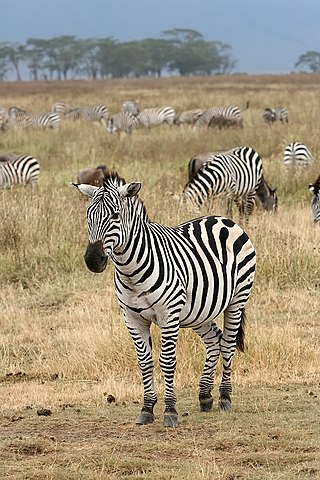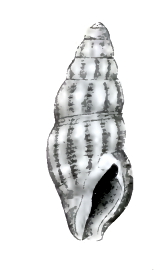
Equidae is the taxonomic family of horses and related animals, including the extant horses, asses, and zebras, and many other species known only from fossils. The family evolved around 50 million years ago from a small, multi-toed ungulate into larger, single-toed animals. All extant species are in the genus Equus, which originated in North America. Equidae belongs to the order Perissodactyla, which includes the extant tapirs and rhinoceros, and several extinct families.

Zebras are African equines with distinctive black-and-white striped coats. There are three living species: Grévy's zebra, the plains zebra, and the mountain zebra. Zebras share the genus Equus with horses and asses, the three groups being the only living members of the family Equidae. Zebra stripes come in different patterns, unique to each individual. Several theories have been proposed for the function of these patterns, with most evidence supporting them as a deterrent for biting flies. Zebras inhabit eastern and southern Africa and can be found in a variety of habitats such as savannahs, grasslands, woodlands, shrublands, and mountainous areas.

The bullhead sharks are members of the genus Heterodontus, the only members of the family Heterodontidae and only living members of the order Heterodontiformes. All are relatively small, with the largest species reaching just 1.65 metres (5.5 ft) in maximum length. They are bottom feeders in tropical and subtropical waters.

The plains zebra is the most common and geographically widespread species of zebra. Its range is fragmented, but spans much of southern and eastern Africa south of the Sahara. Six or seven subspecies have been recognised, including the extinct quagga which was thought to be a separate species. More recent research supports variations in zebra populations being clines rather than subspecies.

The mountain zebra is a zebra species in the family Equidae, native to southwestern Africa. There are two subspecies, the Cape mountain zebra found in South Africa and Hartmann's mountain zebra found in south-western Angola and Namibia.

The zebra shark is a species of carpet shark and the sole member of the family Stegostomatidae. It is found throughout the tropical Indo-Pacific, frequenting coral reefs and sandy flats to a depth of 62 m (203 ft). Adult zebra sharks are distinctive in appearance, with five longitudinal ridges on a cylindrical body, a low caudal fin comprising nearly half the total length, and usually a pattern of dark spots on a pale background. Young zebra sharks under 50–90 cm (20–35 in) long have a completely different pattern, consisting of light vertical stripes on a brown background, and lack the ridges. This species attains a length of 2.5 m (8.2 ft).

The zebra mussel is a small freshwater mussel. The species originates from the lakes of southern Russia and Ukraine, but has been accidentally introduced to numerous other areas and has become an invasive species in many countries worldwide. Since the 1980s, the species has invaded the Great Lakes, Hudson River, Lake Travis, Finger Lakes of NY, and Lake Bonaparte. The adverse effects of dreissenid mussels on freshwater systems have led to their ranking as one of the world's most invasive aquatic species.

A zebroid is the offspring of any cross between a zebra and any other equine to create a hybrid. In most cases, the sire is a zebra stallion. The offspring of a donkey sire and zebra dam, called a donkra, and the offspring of a horse sire and a zebra dam, called a hebra, do exist, but are rare and are usually sterile. Zebroids have been bred since the 19th century. Charles Darwin noted several zebra hybrids in his works.

Grévy's zebra, also known as the imperial zebra, is the largest living wild equid and the most threatened of the three species of zebra, the other two being the plains zebra and the mountain zebra. Named after Jules Grévy, it is found in parts of Kenya and Ethiopia. Superficially, Grévy's zebras' physical features can help to identify it from the other zebra species; their overall appearance is slightly closer to that of a mule, compared to the more "equine" (horse) appearance of the plains and mountain zebras. Compared to other zebra species, Grévy's are the tallest; they have mule-like, larger ears, and have the tightest stripes of all zebras. They have distinctively erect manes, and more slender snouts.

Grant's zebra is the smallest of the seven subspecies of the plains zebra. This subspecies represents the zebra form of the Serengeti-Mara ecosystem and others across central Africa.

The zebra bullhead shark is a bullhead shark of the family Heterodontidae found in the central Indo-Pacific between latitudes 40°N and 20°S, from Japan and Korea to Australia. It is typically found at relatively shallow depths down to 50 m (160 ft), but off Western Australia, it occurs between 150 and 200 m. It can reach a length of 1.25 m (4.1 ft). The reproduction of this bullhead shark is oviparous.

The zebra moray is a species of marine fish in the family Muraenidae. It is the only member of the genus Gymnomuraena, though it sometimes has been included in Echidna instead.

Dendrochirus zebra, known commonly as the zebra turkeyfish or zebra lionfish among other vernacular names, is a species of marine fish in the family Scorpaenidae.
Algae eater or algivore is a common name for any bottom-dwelling or filter-feeding aquatic animal species that specialize in feeding on algae and phytoplanktons. Algae eaters are important for the fishkeeping hobby and many are commonly kept by aquarium hobbyists to improve water quality. They are also important primary consumers that relay the biomass and energy from photosynthetic autotrophes up into the food web, as well as protecting the aquatic ecosystem against algae blooms.
Axis & Allies Naval Miniatures: War At Sea is a standalone miniature wargame, originally produced by Avalon Hill, later by Wizards of the Coast. Axis and Allies Naval Miniatures gameplay is associated with Axis & Allies Miniatures, a World War 2 land battles game also made by Avalon Hill, but the two games are very different. Players take command of miniatures that are 1/1800 scale and represent fleets of individual warships, submarines, and squadrons of Aircraft.

Juliidae, common name the bivalved gastropods, is a family of minute sea snails, marine gastropod mollusks or micromollusks in the superfamily Oxynooidea, an opisthobranch group.

Julia is a genus of minute sea snails, marine gastropod mollusks or micromollusks in the superfamily Oxynooidea.

Pilsbryspira albiguttata is a species of sea snail, a marine gastropod mollusk in the family Pseudomelatomidae, the turrids and allies.

The zebra finches are two species of estrildid finch in the genus Taeniopygia found in Australia and Indonesia. They are seed-eaters that travel in large flocks.















